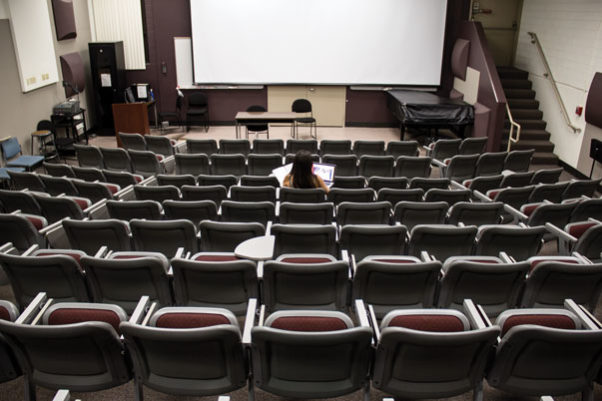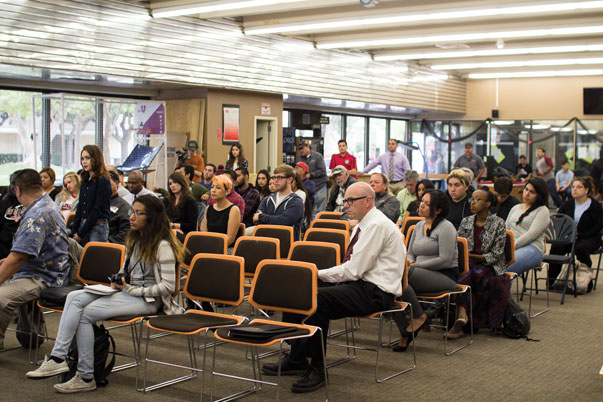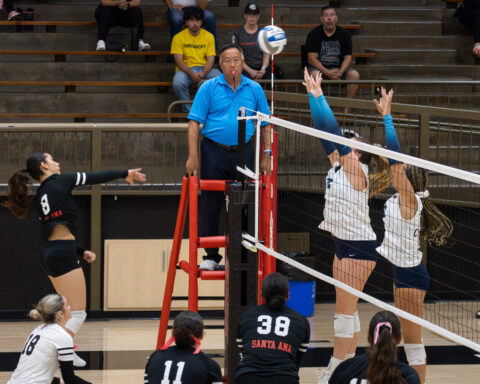
campus: Being absent at the wrong time can cost college thousands
By Haide Hernandez
Living in Southern California makes it tempting to skip class on a sunny 75-degree day.
It’s one time, you tell yourself. You’ll just send a quick email to your professor saying you won’t be there and ask a friend for lecture notes. You figure you’ll catch up on class work later. Everything will be OK.
But students who miss class have a negative economic effect on community colleges. Skipping class on a census day can lead to Santa Ana College losing about $6,500.
Community colleges, like the K-12 system, receive government funding from attendance taken on census days, which take a snapshot of the semester’s enrollment.
The college assesses student attendance through either a weekly or daily census. A weekly census is reported on GE classes like English, math and science, which meet for a full semester. Intersession courses and short-term classes within the regular semester, like a lab class, are reported on a daily census, according to a SAC Academic Affairs report.
Colleges are funded by the number of Full Time Equivalent Students (FTES) the institution can account for.
An FTES is the equivalent of one student enrolled 15 hours per week for two 17.5-week semesters. Think of it as a student taking a full load—about 12 units a semester.
For every FTES, the college receives $6,528, which covers cost components for instruction, student services and other academic support, as calculated by the College Measures website. Part-time students are added together to create FTESs.
“I come to all my classes, I come to get good grades and I understand that the school gets money when students actually show up,” part-time SAC student Daniel Rucker said.
SAC is limited by how many FTES it can receive funding for.
If Santa Ana College accounts for more FTESs than the previous year, there would be no funding for the extra full-time students.
If the college does not meet the expected number of full-time students then the state decreases the amount of funds the school receives. It is a delicate balance for colleges to stay within state-mandated caps.
For the 2012-13 school year SAC was credited for 15,000 FTES. The college went over the FTES cap and did not earn the needed funds for the extra students, according to SAC planning and budget meeting minutes. Out of eight on-campus departments, the Human Services Division, consisting of departments in welding, criminal justice and fire technology, accounted for more than 25 percent of total credited FTES.
The Fall 2012 semester reported 7,200 FTES, but the Spring 2013 semester had a decrease of full-time students, lowering the number to 6,900, amounting to less than the 15,000 FTES cap.
Since the 2008-09 school year, California Community Colleges have cut funding by $809 million and enrollment has decreased by 300,000 students.
“I don’t always show up to class. Sometimes I get busy doing other things, I didn’t have a ride or I get stuck at work,” part-time SAC student Jesse Silva said.
Although there are various reasons for not coming to class, once students register for a course they are making the commitment to attend each time. It is the same commitment athletes and employees make.
In the 2013-14 academic year, the FTES target was missed, but after submitting unaccounted-for students to the state, SAC will receive an additional $225,000 for the 2014-15 year.
These issues were brought up in the SAC planning and budget meeting in December, when SAC Vice President of Academic Affairs Omar Torres announced strategical measures to meet the enrollment target every semester.
Torres said by working with the curriculum committee and the academic senate, a two-year education plan will later be made public to the students and the community. The counseling department will implement education plans for all students, with the student making a follow-up meeting to complete a two-year plan.
In 2012, Proposition 30 provided a way to bring back funding. The act averted an $8.6 million budget cut in the 2012-13 school year and saved 600 course sections, thereby maintaing access to college courses for an estimated 2,000 students.
The balance problem has persisted for several years. SAC was supposed to received $50 million in growth funding to pay for the 2009-10 workload reduction, but only if the FTES target was met. It’s been a work in progress.
“We have not earned it all back and we need to restore it on all levels. Some districts are growing, yet we have not. We are lagging behind on growth,” RSCCD Vice Chancellor Peter Hardash said.
A 2.7 percent attendance increase is needed to gain more FTES. It also depends on students staying fully committed and coming to an air-conditioned class on a 75-degree day.
- Inside el Don’s 2025 Immigration Issue - October 14, 2025
- Talk to us! We’re community reporters - October 14, 2025
- Local punk scene provides support during ICE raids - July 17, 2025











